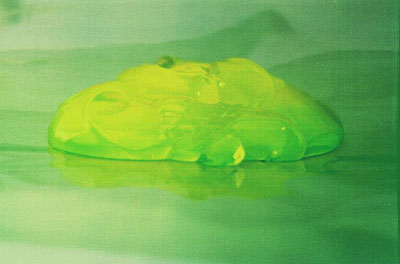 The Kiss of the Muse - 1/16 (1/2), 2003 c-print, wood, plexi; 40 x 50 cm Josephine Pryde Photographie pure? It's been a while since Carl Andre said about Frank Stella's painting that it was not symbolic but that his stripes were the paintbrush's paths on the canvas that did not lead anywhere except into painting. The idea that reduction could lead to an end or even a solution, either with respect to the material properties of the medium or as an immaterial concept, has itself come to an end. But the problems remain: There are still no definite answers regarding the complex relations between representation, medium, and artistic concept. In the case of photography, this is even more evident than in other media. In the early days, the possibilities of the new medium put the reproduction of some reality into question, and as a consequence, the medium was used for technical experiments (multiple exposure, solarization, photogramme etc.). A crucial feature about such strategies is that the process of simulation always remains visible and explicit. Unusual perspectives or close-ups always remind us that the medium is not just a transparent transmitter of images but opens up completely new ways of visual perception and understanding. By and large, such properties of the medium have been lost through its history. By the end of the twentieth century, photography in the arts is either used as a tool for documentation as a concept, or as an excuse to mimic historicist and representational painting and as such serve a questionable nineteenth century nostalgia. In her work, young British artist Josephine Pryde deals with the specific characteristics of the medium again, but naturally from a perspective different from the early days of modernism. The technical experiments and distortions become part of a conceptual meta-level, formal properties of early photography enter her work with all their historic loadedness and are as such also commentaries on later developments and newer media. At a first glance, the photos in this exhibition remind us about the tight connections between science and photography in the early days, but the depicted simulation is itself a simulation. The evaporation of the chemical substance in the image is in a referential relation with the chemical process of developing the film and the print. The properties of the medium and the content of the image are bound tight together and become inseparable. The subjective view is reflected back from the artist's eye to the medium. In a series of older works, a 2 cylinder engine is depicted from a very close angle but there is a spot in the middle distorting the view on the object. Again, there is no fixed point of reference in the work but the artist builds up a complex relation between her perspective, the technical instrument and physical and chemical processes. There is no possibility of reduction, be it one way or the other, since reduction would lead to a static work. Any resulting purity or clarity would be merely apparent, and blur the dynamics of complex interactions between material objects and our minds. "The Kiss of the Muse" does not produce frozen moments but an art that expands over time. Exhibition: 22 January - 27 March 2004 Gallery hours: Tue-Sat 12 - 6 pm Xavier Hufkens Gallery Sint-Jorisstraat 6-8 Rue Saint-Georges B-1050 Brussels Telefon +32 2 639 67 30 Fax +32 2 639 67 38 E-Mail info@xavierhufkens.com www.xavierhufkens.com |